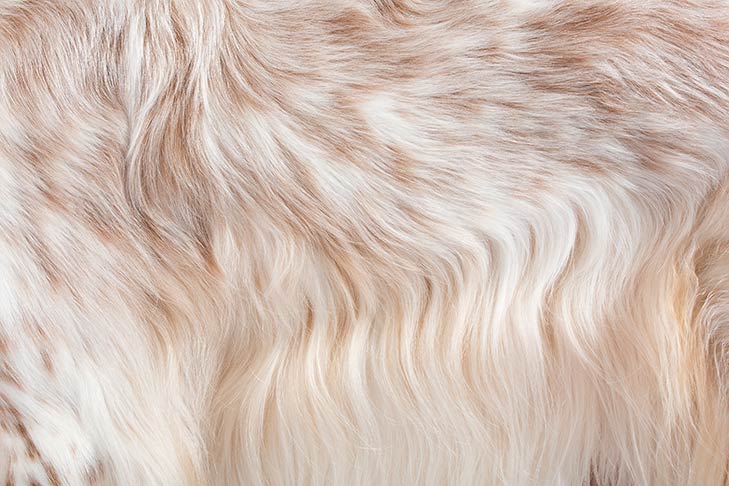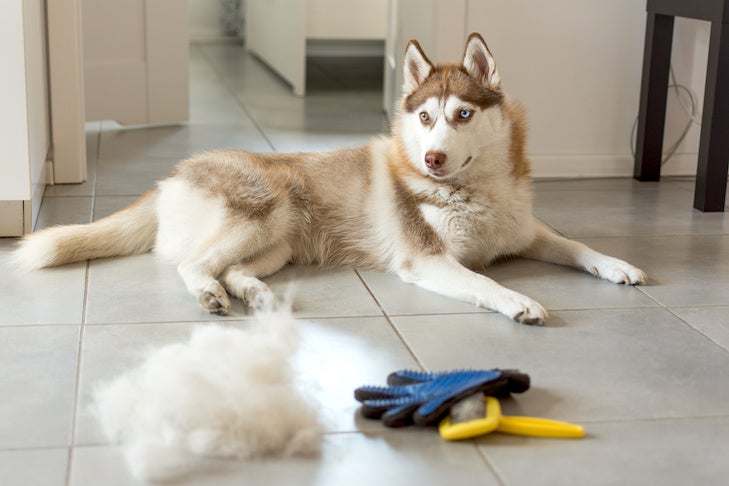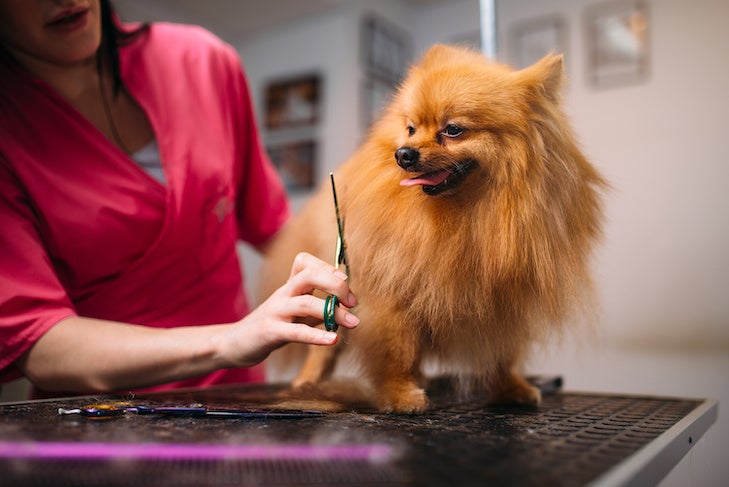“If I could get one idea across in my teachings, it would be that hair and fur are different and must be treated differently.” So says Jennifer Bishop-Jenkins, a Certified Master Groomer with more than four decades of experience. But how do dog hair and fur actually differ from one another?
Do Dogs Have Hair or Fur?
Hair and fur are practical terms to refer to different genetic programs for different types of dog coats. On the cellular level, all canine coats, whether hair or fur, are made of keratin. Practically, however, there’s a huge difference.
The difference lies in how the coat grows. Some coats are genetically programmed to grow to a predetermined length (or PDL). This means they will grow to a certain length, at which point they will stop. Other coats grow to an undetermined length (or UDL), meaning they will keep growing until they are cut or until they break. Dogs with fur have coats that grow to a predetermined length and then stop growing. Dogs with hair will have coats that grow for much longer—sometimes even for years.

Undercoat vs. Outercoat
Dogs often have another kind of coat, variously referred to as undercoat, wool, or secondary hairs. If a dog has both an undercoat and an outercoat (also called guard or primary hairs), they are said to be double-coated. In fact, most dogs are double-coated. The undercoat and outercoat differ in structure.
The outercoat has three fully-formed layers (cuticle, cortex, and medulla), while the undercoat may only have a cuticle and cortex. The outercoat’s hairs are longer and stronger than those in the undercoat. The weaker undercoat hairs grow in and fall out many times a year, often seasonally. Outercoat hairs grow very slowly; there can be long periods during which they may not grow at all.
Despite the seemingly vast array of canine coat types, almost all are explained by the interaction of just three gene variants. The genes controlling the coat growth cycle are responsible for the length of hair: and whether we call what covers our pets either hair or fur.
The Coat Growth Cycle
All outercoats go through three phases of the growth cycle: anagen, catagen, and telogen. The anagen phase is the period of growth that determines coat length. During the catagen phase, the hairs stop growing and the hair follicle shrinks. Telogen is the resting phase; here, the hair basically just stays in the follicle, although the root is detached. Some veterinary dermatologists add a fourth phase (exogen) to describe the period when the hair is shed.

According to Bishop-Jenkins, the longest telogen (or resting) phase occurs in dogs with medium-length fur coats, much like wild wolves. This is why these types of coats do not grow back well (if at all), if they are cut, since the undercoat grows in and falls out more quickly.
Should Hair and Fur Be Groomed Differently?
Bishop-Jenkins advises against shaving fur-type coats. Instead, she recommends de-shedding them. Why? She explains, “Fur stays in the telogen phase for a very long time. So if you shave off the top part of a fur guard hair, the undercoat will come back in a fast-growing rage without the topcoat to protect it.”
She adds that, in many situations, the topcoat’s structural hairs don’t grow back. As a result, the undercoat can get bristly and matted. She notes, “You may think you’re making your life easier by shaving a fur-coated dog, but you’re making it harder in the long run.”
On the other hand, you can go ahead and trim a hair coat. In fact, it’s recommended that you trim a hair coat often to keep its length manageable.

Should Hair and Fur Be Treated Differently?
Fur-type coats need to be specially nourished. Bishop-Jenkins says, “Fur-type coats have a lot more hairs in each follicle—and many more follicles. Short fur tends to turn over: that is, shed and regrow more often compared to longer hair. That means fur coats should be nourished with conditioners that contain minerals (the building blocks of coat growth).
“Long hair may stay on the dog for months or even years,” Bishop-Jenkins continues. “It needs protection from drying out and breaking, so it needs moisturizers to keep the longer hair ends hydrated and healthy.”
Do Dogs With Fur or Dogs With Hair Shed More?
Because of the undercoat’s turnover rate, fur coats shed more than hair coats. Fur undercoats shed substantially twice a year. When your dog is shedding their undercoat, make sure to brush or blow it out. That way, the undercoat (which is being shed) won’t get matted or trapped beneath the outercoat.
“Dogs with hair do tend to be less allergenic than dogs with fur,” says Bishop-Jenkins. “That’s because along with shedding less coat, they shed less skin or dander—the component of dog skin to which some people are more allergic. Hair traps dander better and makes less of it.”
Which Dogs Have Hair? Which Dogs Have Fur?
The most obvious breed with hair is the Poodle. “The Poodle has an extremely long anagen growth phase,” says Bishop-Jenkins. “I once had a Poodle I was able to measure coat growth on, and it was still growing—that is, the same hairs were still present and lengthening—after four years. I’ve even heard one report of an apparently long-lived Poodle that still had the same hairs still getting longer for twenty years!” Other breeds with hair include the Maltese, Havanese, and Puli. Some breeds with fur include the Labrador Retriever, Golden Retriever, Collie, and French Bulldog.

Bishop-Jenkins points out that there are many sub-groupings of dogs with hair and dogs with fur. For example, the Poodle has curly hair, with bent-shaped hair shafts and follicles. The Yorkshire Terrier has long, straight hairs and a straight follicle. The Portuguese Water Dog has long, wavy hairs that are kidney-shaped and have a bent follicle. Each type requires different grooming and conditioning. Similarly, fur coat types can be subdivided according to length and wiriness.
This article is intended solely as general guidance, and does not constitute health or other professional advice. Individual situations and applicable laws vary by jurisdiction, and you are encouraged to obtain appropriate advice from qualified professionals in the applicable jurisdictions. We make no representations or warranties concerning any course of action taken by any person following or otherwise using the information offered or provided in this article, including any such information associated with and provided in connection with third-party products, and we will not be liable for any direct, indirect, consequential, special, exemplary or other damages that may result, including but not limited to economic loss, injury, illness or death.

